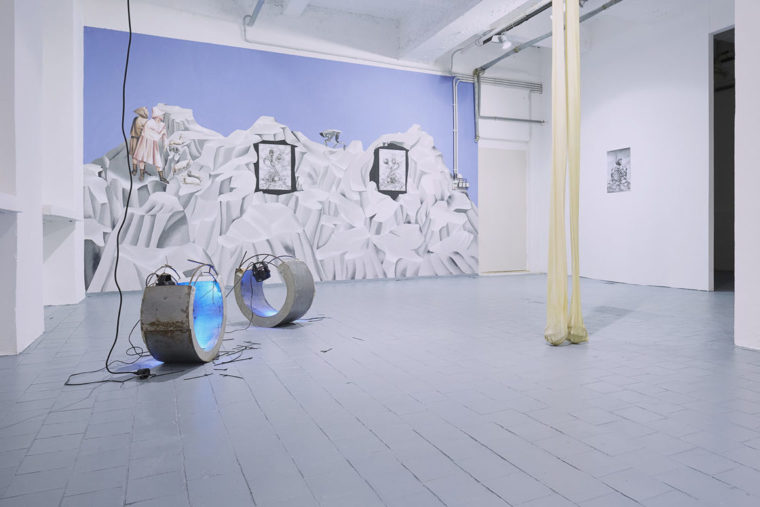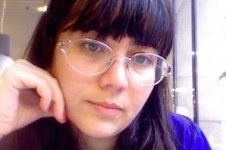Search
To search for an exact match, type the word or phrase you want in quotation marks.
A*DESK has been offering since 2002 contents about criticism and contemporary art. A*DESK has become consolidated thanks to all those who have believed in the project, all those who have followed us, debating, participating and collaborating. Many people have collaborated with A*DESK, and continue to do so. Their efforts, knowledge and belief in the project are what make it grow internationally. At A*DESK we have also generated work for over one hundred professionals in culture, from small collaborations with reviews and classes, to more prolonged and intense collaborations.
At A*DESK we believe in the need for free and universal access to culture and knowledge. We want to carry on being independent, remaining open to more ideas and opinions. If you believe in A*DESK, we need your backing to be able to continue. You can now participate in the project by supporting it. You can choose how much you want to contribute to the project.
You can decide how much you want to bring to the project.

Through the speculative criticism, meaning, through the exploration of the questions rather than the formulation of answers, this exhibition, curated by Àngels Díaz Tena Miralda, investigates the possible archaeologies of the future pondering over their post-human borders. In this way, this proposal avoids the passive and one-dimensional self-complacency facing the most severe diagnoses and projections about the current ecological crisis. And this is how the “extra-planetary” commitment promised in its name, evokes at the same time a mirror and window, reflection and projection, distance exercise with the terrestrial. A present that dissolves in inorganic and non-biodegradable elasticity of a near future. A disturbing present that is invoked from the inaugural text of the catalogue, is rocked by the dark poetry of the prophecies of the Anthropocene:
“We are dragged by gravity, by the slowness of the invention, by the viscosity of wet concrete. While a small organic sprout died from the exposure to the moonlight, our planet, our home, is increasingly replete with toxicity.”
As if it were an astronaut in a pilot test, the spectator will break the Earth’s escape velocity, the Earth’s gravity force, but only to prove that out there, in that “extra-planetary” commitment that promises this exhibition, it will only find our most prosaic terrestrial reality. An extended and elastic present where the concrete, the traces of the promise of the utopian modernism embodied in the Bauhaus acquires non-human agency in sculptures with disturbing attributes of Evita Vasiljeva. The agonizing echoes of modernism are also invoked through the pospornography and the horizon of a post-human sexuality. Alloys of mutant meat and kinetic geometry merge questioning contemporary visual regimes in Ad Minoliti’s work. A plastic lens that is also present in the weird retro-futurism and cyberpunk with echoes of suprematist architecture of the imaginary founded on the murals and paintings by Borond Keresztesi.

Installation view of the exhibition, ‘Extra-Planetary Commitment’, lítost gallery, Prague, 16 March 2019 – 28 April 2019. From left to right: Evita Vasiljeva, ‘Hormones’, (2017), metal, concrete, wood, cable ties, noise sensitive light, wires, each part 25 cm x 57 cm x 57 cm – Courtesy of the artist gallery; Botond Keresztesi, “Miss Universe 1”, black colour airbrush on paper, 29.7 cm x 42 cm – Courtesy of the artist; Botond Keresztesi, “Miss Universe 2”, black colour airbrush on paper, 29.7 cm x 42 cm – Courtesy of the artist; Evita Vasiljeva – ‘There is no Grace in Shrinking’, (2017),latex, pump, plastic tubes, various sizes – Courtesy of the artist; And Botond Keresztesi, “The Audience”, black colour airbrush on paper, 29.7 cm x 42 cm – Courtesy of the artist. Photograph by Lenka Glisníková. © lítost
Nevertheless, the piece that perhaps summarizes with its questioning power of this exhibition is a rectangle of grey sand with suspiciously bright sparkles that the spectator will find as soon as he enters the Lítost gallery. Somewhat disturbing in its colour, an ashen grey warns that it is not exactly sand and all the promises of happiness that the beach landscape assures. This will only be the introduction. With the complementary video with this piece, we attend a setting in abyss. These are the ashes of the omnipresent plasma screens that, like black mirrors, become the skin of our present. An “extra-planetary” surface that at the same time, evokes the skin of an amphibious animal. Among the human, the animal and the post-human, the organic and inorganic in Mehr Fantasie (2017-2018) by Julia Varela the toxicity that inhabits us is materialized ceasing to be just a metaphor to become a dark indication of the surface that we step on and breathe.
From the introductory texts of its catalogue, this exhibition invokes the imaginary of the classic science fiction such as R.U.R.(1920) by Karel Capek and The Dispossessed (1974) by Ursula K. Le Guin that considered the relations between modernity, alienation and utopic speculation in a precursor way in their respective historical contexts. However, Extra-Planetary Commitment only takes us to the past to formulate a proposal of resurrection from the ashes of these future old-fashioned claiming:“Do not let the dream die-this is a bid to keep exploring other worlds”.Utopia has died. Long life to utopia predict these pieces, these fictions of a continuous present, extended present, that kainos where we inhabit this short time, the transition from Anthropocene- Capitalocene-Plantationcene to the Chthulucene warned by Donna Haraway (2016) in Staying with The Trouble. Making Kin in the Chthulucene, 2016). From the concept of Chthuluceno Haraway resists falling into a new in a definition of the present determined by Anthropos. Like this avoids the common place to gloat over a story of the dystopian apocalypse from the anthropocentric perspective and proposes a strategy of dissent that accepts speculation, in the sense of reflection and conjecture, on the possibility of a trans-species ecojustice. A compost fable, emerging between concrete surfaces, blooming between polluting wastes. As if, just as in the plasma ashes of Julia Varela, the dark compost of the Chthulucene nested new possibilities of emergence of new mythologies and narratives in a planet of constant mutation beyond human agency.

Julia Varela, ‘Mehr Fantasie’, (2017 – 2018), super HD, stereo, 20m 4s – Courtesy of the artist. Photograph by Lenka Glisníková. © lítost

Ana is fascinated to dive into books and movies, to approach with caution those tentacles that lie in the depths and to return to count what she has seen. She has published “Este es el momento exacto en que el tiempo empieza a correr” (Premio Antonio Colinas de Poesía Joven), the novels “La puerta del cielo” and “Hemoderivadas”, “Constelaciones familiares” (short stories, Premio Celsius Semana Negra de Gijón) and “Érase otra vez. Contemporary fairy tales” (essays). She currently lives and works between Berlin and El Paso, Texas, where she is a Bilingual MFA Fellow in Creative Writing at UTEP. Some of her texts have been translated into Portuguese, Italian, Polish, Lithuanian, German and English.
"A desk is a dangerous place from which to watch the world" (John Le Carré)